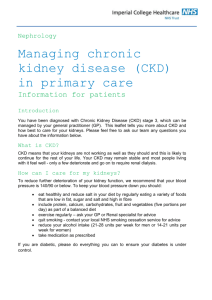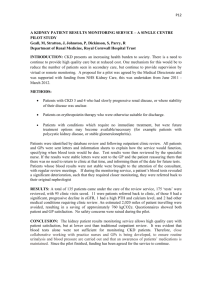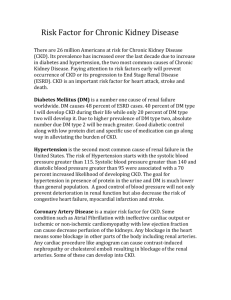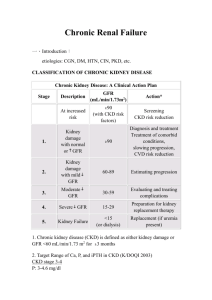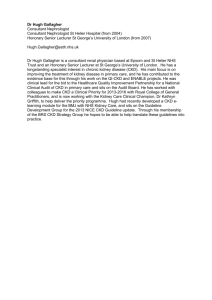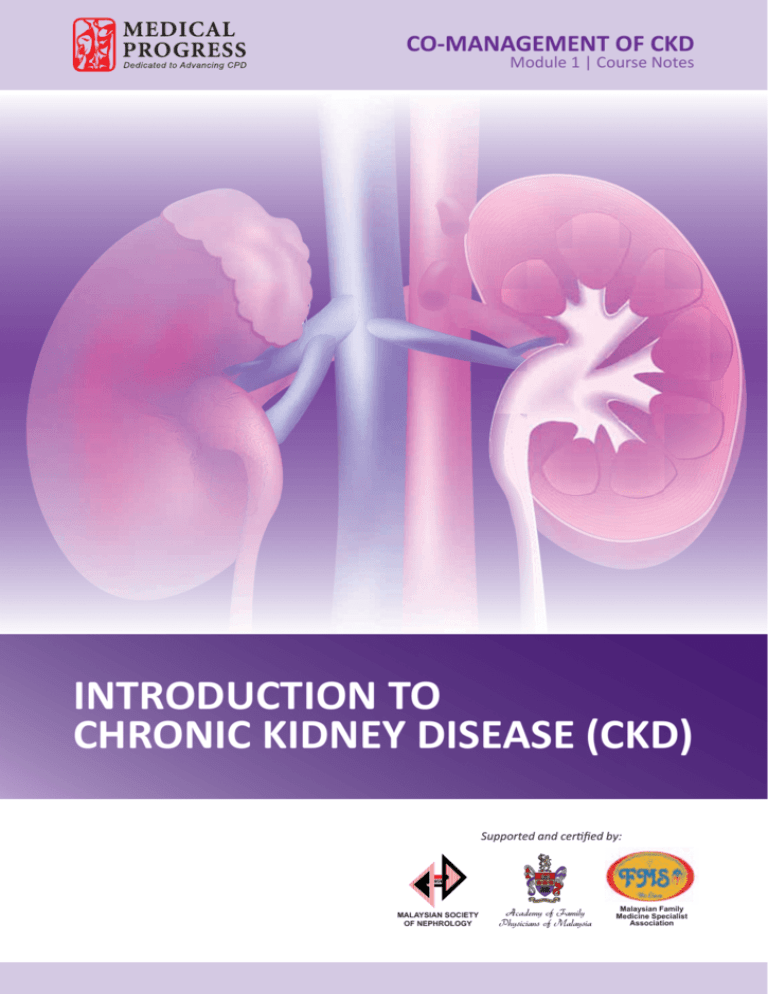
CO-MANAGEMENT OF CKD
Module 1 | Course Notes
INTRODUCTION TO
CHRONIC KIDNEY DISEASE (CKD)
Supported and certified by:
MALAYSIAN SOCIETY
OF NEPHROLOGY
Malaysian Family
Medicine Specialist
Association
Table of Contents
CHRONIC KIDNEY DISEASE (CKD)
4
Definition
4
Pathophysiology
5
Prevalence and incidence
5
Age
6
Mortality and morbidity
6
Stages of CKD
7
Causes of CKD
7
Diagnosis
8
Laboratory studies
9
Imaging studies
ABSTRACTS
10
Can we prolong life of patients with advanced CKD: what is the clinical evidence?
10
Cardiovascular complications in CKD patients: role of oxidative stress.
11
Undiagnosed kidney disease in hospitalised patients: an opportunity for improvement.
12
Quality of life in CKD.
13
End-stage renal disease (ESRD) preceded by rapid declines in kidney function: a case series.
13
Assessing kidney function in Asia.
14
Cardiorenal syndromes: pathophysiology to prevention.
14
Prediction of ESRD and death among people with CKD: the Chronic Renal Impairment in Birmingham
(CRIB) prospective cohort study.
15
Drug therapy in patients with chronic renal failure.
16
Possible link between metabolic syndrome and chronic kidney disease in the development of
cardiovascular disease.
CHRONIC KIDNEY DISEASE
Definition
Chronic kidney disease (CKD) is a serious condition associated with premature mortality, decreased
quality of life, and increased health-care expenditures.1 CKD refers to an irreversible loss of renal
function that develops due to a multifactorial etiology over a period of a few years. Initially it starts as
a biochemical abnormality and progresses in stages. Earlier stages of CKD can be detected through
routine laboratory measurements. Loss of renal function happens progressively leading to loss of
excretory, metabolic and endocrine functions.
The Kidney Disease Outcomes Quality Initiative (KDOQI)2 of the National Kidney Foundation (NKF)
defines CKD as:
1. Kidney damage for three or more months, as defined by structural or functional abnormalities of
the kidney, with or without decreased glomerular filtration rate (GFR) manifest by either:
a. Pathological abnormalities; or
b. Markers of kidney damage, including abnormalities in the composition of the blood or urine, or
abnormalities in imaging tests.
2. GFR less than 60 mL/min/1.73 m2 for three or more months. Whatever the underlying etiology, the
destruction of renal mass with irreversible sclerosis and loss of nephrons leads to a progressive
decline in GFR. The clinical signs and symptoms of renal failure manifest during the later stages
of the condition. This stage is sometimes referred to as uremia.3
Untreated CKD can result in end-stage renal disease (ESRD) and necessitate dialysis or kidney
transplantation.
Pathophysiology
Approximately one million nephrons are present in each kidney, each contributing to the total GFR.
Regardless of the etiology of renal injury, with progressive destruction of nephrons, the kidney has
an innate ability to maintain GFR by hyperfiltration and compensatory hypertrophy of the remaining
healthy nephrons. This nephron adaptability allows for continued normal clearance of plasma solutes
so that substances such as urea and creatinine start to show significant increases in plasma levels
only after total GFR has decreased to 50%, when the renal reserve has been exhausted. The plasma
creatinine value will approximately double with a 50% reduction in GFR. A rise in plasma creatinine
from a baseline value of 0.6 mg/dL to 1.2 mg/dL in a patient, although still within the reference range,
actually represents a loss of 50% of functioning nephron mass.
The residual nephron hyperfiltration and hypertrophy, although beneficial for the reasons noted, has
been hypothesized to represent a major cause of progressive renal dysfunction. This is believed to
occur because of increased glomerular capillary pressure, which damages the capillaries and leads
initially to focal and segmental glomerulosclerosis and eventually to global glomerulosclerosis. This
hypothesis has been based on studies of five-sixths nephrectomized rats, who develop lesions that
are identical to those observed in humans with CKD.
4
Factors other than the underlying disease process and glomerular hypertension that may cause
progressive renal injury include the following:
● Systemic hypertension
● Acute insults from nephrotoxins or decreased perfusion
● Proteinuria
● Increased renal ammoniagenesis with interstitial injury
● Hyperlipidemia
● Hyperphosphatemia with calcium phosphate deposition
● Decreased levels of nitrous oxide
● Smoking.
Prevalence and Incidence
CKD is a worldwide public health problem and is now recognized as a common condition that is
associated with an increased risk of cardiovascular disease and chronic renal failure (CRF). In the
United States the prevalence and incidence of kidney failure treated by dialysis and transplantation
have increased from 1988 to 2004. This could be due to the increasing prevalence of diabetes and
hypertension.2 A similar trend is seen in Malaysia where diabetes is increasingly prevalent.
Age
CKD is found in persons of all ages. The normal annual mean decline in the GFR with age from
the peak GFR (approximately 120 mL/min/1.73 m2) attained during the third decade of life is
approximately 1 mL/min/1.73 m2, reaching a mean value of 70 mL/min/1.73 m2 at age 70 years.
Nonetheless, in the United States, the highest incidence rate of ESRD occurs in patients older than
65 years. From the 3rd National Health and Nutrition Examination Survey (NHANES III) data, the
prevalence of CKD was 37.8% among patients older than 70 years. Besides diabetes mellitus and
hypertension, age is an independent major predictor of CKD. The biologic process of aging initiates
various structural and functional changes within the kidney. Renal mass progressively declines with
advancing age. Glomerulosclerosis leads to a decrease in renal weight. Histologic examination is
notable for a decrease in glomerular number of as much as 30% to 50% by age 70 years.
Ischemic obsolescence of cortical glomeruli is predominant, with relative sparing of the renal medulla.
Juxtamedullary glomeruli see a shunting of blood from the afferent to efferent arterioles, resulting in
redistribution of blood flow favoring the renal medulla. These anatomical and functional changes in
renal vasculature appear to contribute to an age-related decrease in renal blood flow.
Given the histologic evidence for nephronal senescence with age, a decline in the GFR is expected.
However, a wide variation in the rate of decline in the GFR is reported because of measurement
methods, race, gender, genetic variance, and other risk factors for renal dysfunction. Because of
these anatomical and physiological changes, elderly patients with CKD may behave differently, in
terms of progression and response to pharmacological treatment, than younger patients.
5
CHRONIC KIDNEY DISEASE
Mortality and Morbidity
CKD is a major cause of morbidity and mortality, particularly at the later stages. The 5-year survival
rate for a patient undergoing chronic dialysis in the United States is approximately 35%. This is
approximately 25% in patients with diabetes. The most common cause of death in the dialysis
population is cardiovascular disease.
Among patients with ESRD aged 65 years and older, the mortality rates are 6 times higher than in
the general population. In 2003, over 69,000 dialysis patients enrolled in the ESRD program died
(annual adjusted mortality rate of 210.7 per 1000 patient-years at risk for the dialysis population,
which represents a 14% decrease since peaking at 244.5 per 1000 patient-years in 1988). The
highest mortality rate is within the first 6 months of initiating dialysis, which then tends to improve
over the next 6 months, before increasing gradually over the next 4 years.
The mortality rates associated with hemodialysis are striking and indicate that the life expectancy
of patients entering into hemodialysis is markedly shortened. At every age, patients with ESRD
on dialysis have significantly increased mortality when compared with non-dialysis patients and
individuals without kidney disease. At age 60 years, a healthy person can expect to live for more
than 20 years, whereas the life expectancy of a 60-year-old patient starting hemodialysis is closer
to 4 years.
Stages of CKD
The stages of CKD proposed by KDOQI in the table below (Table 1) is followed internationally. The
table also lists the potential complications due to the reduced GFR.
Table 1: Stages of CKD with potential complications of reduced GFR.
Stage
GFR* (mL/min/1.13m2)
Description
≥ 90
1
Kidney damage# with normal or ↑GFR
2
Kidney damage with mild ↓GFR
60-89
3
Moderate ↓ in GFR
30-59
4
Severe ↓ in GFR
15-29
5
Kidney failure
#
< 15 or on dialysis
Potential complications of reduced GFR*
● Anemia, including functional iron deficiency
● BP increases
● Calcium absorption decreases
● Dyslipidemia/heart failure/volume overload
● Hyperkalemia
● Hyperparathyroidism
● Hyperphosphatemia
● Left ventricular hypertrophy
● Metabolic acidosis
*The listed complications are not specific to CKD and may indicate other conditions. These complications are generally noted with the decreased GFR.
#Kidney damage is defined as demonstrated pathological findings in the kidney by biopsy or imaging studies or abnormal laboratory findings in blood or urine tests (proteinuria,
albuminuria, hematuria or presence of white blood cells, casts).
6
The KDOQI definition and the classification of CKD allow better communication and intervention
at the different stages. In stage 1 and stage 2 CKD, GFR alone does not clinch the diagnosis.
Other markers of kidney damage, including abnormalities in the composition of blood or urine or
abnormalities in imaging tests, should also be present in establishing a diagnosis of stage 1 and
stage 2 CKD.
Causes of CKD
Epidemiological studies show an increased risk for CKD, especially kidney failure, among individuals
with certain clinical and sociodemographic characteristics. This suggests that there are risk factors
for CKD. The morbidity and mortality due to CKD could be reduced greatly by evaluating individuals
with risk factors, to enable earlier detection, and management. This is more important, since CKD,
by itself, does not exhibit any symptoms during the early stages and it is not practically possible to
routinely screen the whole population for CKD. Monitoring the population at risk is a more feasible
solution. The conditions that are termed as risk factors for development of CKD are:
Clinical conditions
Diabetes
Urinary tract infections
Family history of CKD
Exposure to certain drugs
Hypertension
Urinary stone
Recovery from
acute kidney failure
Autoimmune disease
Lower urinary tract obstruction
Reduction in kidney mass
Low birth weight
Systemic infections
Neoplasia
Sociodemographic factors
Older age Ethnicity Exposure to certain chemical and environmental conditions
Low income/education
Among these risk factors, diabetes is an ever increasing threat in the Malaysian population. The
number of people affected with diabetes is steadily increasing in the Malaysian population. This
increasing group of diabetics will adversely increase the number of people with CKD. The costs of
managing people with CKD put an enormous strain on the public health system.
Diagnosis
Earlier stages of kidney disease can be detected through laboratory testing. Measurement of serum
creatinine and estimation of GFR can identify patients with reduced kidney function. Measurement
of urinary albumin excretion can identify some, but not all, patients with kidney damage. Screening
asymptomatic individuals at increased risk could allow earlier detection of CKD. Until recently,
recommendations for screening for CKD in adults were largely focused on patients with hypertension
due to the association of hypertension with CKD. However recent analysis of the 3rd National Health
and Nutrition Examination Survey (NHANES III) database indicated that only 70% of individuals in
the United States with elevated serum creatinine had hypertension.
Screening of all individuals with hypertension and diabetes with appropriate measurement and
interpretation of urine albumin and serum creatinine could identify a large number of patients with
earlier stages of CKD. The challenge is, in identifying the disease early, as early diagnosis and
treatment can prevent progression of the condition into final stages thus preventing morbidity and
mortality greatly.
7
CHRONIC KIDNEY DISEASE
Laboratory Studies
Laboratory diagnostic tests for CKD are focused on assessing the functioning level of the kidney.
CKD affects other systems in the body due to the various effects caused by the excretory malfunction
of the kidney. Many tests can be advised to diagnose CKD. Some of the tests also serve as an
indicator for the cause or effect of CKD. The following tests may be indicated:
● Serum electrolytes, BUN, and creatinine - The BUN and creatinine levels will be elevated in
patients with CKD. Hyperkalemia or low bicarbonate levels may be present in patients with CKD.
● Serum calcium, phosphate, vitamin D, and intact parathyroid hormone (PTH) levels are
obtained to look for evidence of renal bone disease.
● CBC count - Normochromic normocytic anemia is commonly seen in CKD. Other underlying
causes of anemia should be ruled out.
● Serum albumin - Patients may have hypoalbuminemia due to urinary protein loss or malnutrition.
● Lipid profile - A lipid profile should be performed in all patients with CKD because of their increased
risk of cardiovascular disease.
● Urinalysis - Dipstick proteinuria may suggest a glomerular or tubulointerstitial problem. The urine
sediment finding of RBCs, RBC casts, suggests proliferative glomerulonephritis. Pyuria and/or
WBC casts are suggestive of interstitial nephritis (particularly if eosinophiluria is present) or urinary
tract infection.
● Spot urine collection for total protein-to-creatinine ratio allows reliable approximation
(extrapolation) of total 24-hour urinary protein excretion. A value of greater than 2 g is considered
to be within the glomerular range, and a value of greater than 3-3.5 g is within the nephrotic range;
less than 2 is characteristic of tubulointerstitial problems.
● Twenty-four hour urine collection for total protein and creatinine clearance.
In certain cases, the following tests may be ordered as part of the evaluation of patients with CKD:
● Serum and urine protein electrophoresis to screen for a monoclonal protein possibly representing
multiple myeloma.
● Antinuclear antibodies (ANA), double-stranded DNA antibody levels to screen for systemic
lupus erythematosus.
● Serum complement levels - May be depressed with some glomerulonephritides.
● C-ANCA and P-ANCA levels - Helpful if positive in diagnosis of Wegener granulomatosis and
polyarteritis nodosa or microscopic polyangiitis, respectively.
● Anti–glomerular basement membrane (anti-GBM) antibodies - Highly suggestive of underlying
Goodpasture syndrome.
● Hepatitis B and C, HIV, Venereal Disease Research Laboratory (VDRL) serology - Conditions
associated with some glomerulonephritides.
8
Imaging Studies
Imaging studies help in assessing the damage in the physical structure of the kidneys. Some of the
indicated imaging studies are:
● Plain abdominal x-ray - Particularly useful to look for radio-opaque stones or nephrocalcinosis.
● Intravenous pyelogram - Not commonly used because of potential for intravenous contrast renal
toxicity; often used to diagnose renal stones.
● Renal ultrasound - Small echogenic kidneys are observed in advanced renal failure. Kidneys
usually are normal in size in advanced diabetic nephropathy, where affected kidneys initially are
enlarged from hyperfiltration. Structural abnormalities, such as polycystic kidneys, also may be
observed. This is a useful test to screen for hydronephrosis, which may not be observed in early
obstruction, or involvement of the retroperitoneum with fibrosis, tumor, or diffuse adenopathy.
Retrograde pyelogram may be indicated if a high index of clinical suspicion for obstruction exists
despite a negative study finding.
● Renal radionuclide scan - Useful to screen for renal artery stenosis when performed with captopril
administration but is unreliable for GFR of less than 30 mL/min/1.73m2; also quantitates differential
renal contribution to total GFR.
● CT scan - CT scan is useful to better define renal masses and cysts usually noted on ultrasound.
Also, it is the most sensitive test for identifying renal stones. IV contrast-enhanced CT scans should
be avoided in patients with renal impairment to avoid acute renal failure; this risk significantly
increases in patients with moderate-to-severe CKD. Dehydration also markedly increases this
risk.
● MRI is very useful in patients who require a CT scan but who cannot receive intravenous contrast.
It is reliable in the diagnosis of renal vein thrombosis, as are CT scan and renal venography.
Magnetic resonance angiography also is becoming more useful for diagnosis of renal artery
stenosis, although renal arteriography remains the criterion standard.
● Voiding cystourethrogram (VCUG) - Criterion standard for diagnosis of vesicoureteral reflux.
References:
1. CDC. Prevalence of Chronic Kidney Disease and Associated Risk Factors - United States, 1999-2004 available at http://www.cdc.gov/mmwr/preview/mmwrhtml/mm5608a2.htm
accessed on 11 May 2011.
2. National Kidney Foundation. KDOQI Clinical Practice Guidelines for Chronic Kidney Disease: Evaluation, Classification and Stratification. Am J Kidney Dis 2002;39 (supp 1):S1S266.
3. Innes JA. Davidson’s Essentials of Medicine. 1st Edition:Churchill Livingstone Elsevier;2009.
4. Coresh J, Wei GL, McQuillan G, et al. Prevalence of high blood pressure and elevated serum creatinine level in the United States: Findings from the third National Health and
Nutrition Examination Survey (1988–1994). Arch Intern Med 2001;161:1207–1216.
9
ABSTRACTS
Pol Arch Med Wewn. 2011 Mar;121(3):88-93.
Cardiol Res Pract. 2011 Jan 2;2011:156326.
Can we prolong life of patients
with advanced chronic kidney
disease: what is the clinical
evidence?
Cardiovascular complications in
CKD patients: Role of oxidative
stress.
Gosmanova EO, Le NA.
Stompór T, Olszewski A, Kierzkowska I.
Source
Department of Nephrology, Hypertension and
Internal Medicine, University of Warmia and
Mazury, Olsztyn, Poland. stompin@mp.pl
Abstract
The risk of death in patients with advanced
chronic kidney disease (CKD) is markedly
higher than in the population without CKD,
even in patients suffering from advanced
cardiovascular disease. Among several clinical
features of CKD, the following are considered
the most important areas of therapeutic
intervention: hypertension, lipid abnormalities,
mineral and bone disorders of CKD (previously
known as renal osteodystrophy), renal anemia,
and uremic toxicity. However, numerous
treatment strategies, which are applied based
on the understanding of underlying pathologies,
did not result in significantly improved
prognosis. These strategies include lowering
of blood pressure, use of statins, control of
hyperphosphatemia and hyperparathyroidism,
erythropoesis-stimulating agents, use of better
and more biocompatible dialysis membranes,
and higher dialysis dose. In this critical review,
we discuss the most important, large clinical
trials, in which the above therapies failed to
show desirable results and to reduce mortality
in patients with advanced CKD.
10
Source
Nephrology Division, Department of Medicine,
The University of Tennessee Health Science
Center, Memphis, TN 38103, USA.
Abstract
Starting with the early stages, patients with
chronic kidney disease (CKD) experience
higher burden of cardiovascular disease (CVD).
Moreover, CVD complications are the major
cause of mortality in CKD patients as compared
with complications from chronic kidney failure.
While traditional CVD risk factors, including
diabetes, hypertension, hyperlipidemia, obesity,
physical inactivity, may be more prevalent
among CKD patients, these factors seem to
underestimate the accelerated cardiovascular
disease in the CKD population. Search for
additional biomarkers that could explain the
enhanced CVD risk in CKD patients has gained
increasing importance. Although it is unlikely
that any single nontraditional risk factor would
fully account for the increased CVD risk in
individuals with CKD, oxidative stress appears
to play a central role in the development and
progression of CVD and its complications. We
will review the data that support the contribution
of oxidative stress in the pathogenesis of CVD
in patients with chronic kidney failure.
Nefrologia. 2011 Jan 21;31(1):70-75.
Undiagnosed kidney disease
in hospitalised patients: an
opportunity for improvement.
[Article in English, Spanish]
Campos Gutiérrez B, Lou Arnal LM, Gimeno
Orna JA, Gracia García O, Cuberes Izquierdo
M, Turón Alcaine JM, Arnaudas Casanova
L, Boned Juliani B, Bielsa García S, Sanjuán
Hernández-French A.
Source
Internal Medicine Department, Hospital de
Alcañiz, Teruel, Spain.
Abstract
OBJECTIVES:
In hospitalised patients, chronic kidney disease
(CKD) is associated with a high risk of morbidity,
mortality and drug toxicity. We identified care
improvement opportunities in hospitalised
patients with kidney disease in a regional
hospital.
prior to admission was available for 50 patients
(25%); however this diagnosis figures in the
clinical history in 14 of them (28%), and in the
discharge report in 17 (34%). Kidney function
deterioration was detected in 68 of the 146
patients who had kidney function monitoring
during hospitalisation (46.5%). This information
was contained in the clinical history in only 50%
of cases and in the discharge report in 33.8%.
CONCLUSIONS:
The incidence of CKD prior to admission
and deterioration of kidney function during
hospitalisation are high. Often these diagnoses
are not included in clinical progress reports or
in the discharge report, reflecting poor condition
awareness on the part of our colleagues.
Implementation of a clinical protocol and
its diffusion throughout the hospital may be
important tools to achieving more efficient and
consistent management of these conditions.
MATERIAL AND METHOD:
Clinical audit: 200 patients hospitalised for
any reason in Alcañiz Hospital (Spain) were
randomly selected. The data sources were
laboratory data, clinical history and discharge
reports. RIFLE criteria were applied to define
kidney function deterioration. As process quality
indicators we used: 1) percentage of hospitalised
patients with at least one determination of
kidney function during admission. 2) percentage
of patients who met criteria for CKD and/or
kidney function deterioration and who had this
diagnosis recorded in clinical progress reports.
3) percentage of patients who met criteria
for CKD and/or kidney function deterioration
and who had this diagnosis recorded in the
discharge report.
RESULTS:
Mean age was 71.1 (17) years, 42% women,
63% admitted to medical areas and 37%
to surgical areas. Some 194 patients had a
kidney function determination at admission;
however during their stay kidney function was
not monitored in 54 patients (27%), especially
in surgical areas. CKD diagnosis by analyses
11
ABSTRACTS
Nefrologia. 2011 Jan 21;31(1):91-96.
Quality of life in chronic kidney
disease.
[Article in English, Spanish]
Fructuoso M, Castro R, Oliveira L, Prata C,
Morgado T.
Abstract
BACKGROUND:
The evaluation of health-related quality of life
(QOL) in chronic kidney disease intends to
quantify its consequences, according to the
patient’s subjective perception.
AIM:
To evaluate the health-related QOL in four
groups of patients followed at our Nephrology
Department:
chronic
kidney
disease
(CKD) stages 1-4, kidney transplant (KT),
haemodialysis (HD) and peritoneal dialysis
(PD) patients.
PATIENTS AND METHODS:
Thirty patients with CKD stages 1-4 and 30 KT
patients were randomly selected. All patients
from our Haemodialysis and Peritoneal Dialysis
Units with capacity to answer the inquiry (37
and 14, respectively) were also selected.
The instruments applied were the SF-36 and
KDQOL-SF 1.3.
RESULTS:
The four groups presented better results in the
Social Functioning scale (77.68 + 18.46 in PD;
74.17 + 29.53 in KT; 66.81 + 31.39 in CKD 1-4;
62.16 + 32.84 in HD; p = 0.192). The lowest
results appeared in the General Health scale
(39.92 + 19.12 in CKD; 45.95 + 21.56 in HD;
47.13 + 23.15 in KT; 51.79 + 18.89 in PD; p =
0.321). Peritoneal dialysis patients achieved the
best results in the Physical Health Component,
but this difference disappeared after adjustment
to confounding factors. Age, gender and
haemoglobin level were the variables related
with QOL. However, PD patients obtained
better scores comparing to HD patients in the
following KDQOL-SF scales: Effects of kidney
disease, Burden of kidney disease and Patient
satisfaction (p <0.05).
12
CONCLUSIONS:
Health-related QOL was better in peritoneal
dialysis patients comparing to haemodialysis
patients in specific scales of chronic kidney
disease. Age, gender and haemoglobin level
interfered with health-related QOL.
BMC Nephrol. 2011 Feb 1;12:5.
Singapore Med J. 2010 Nov;51(11):888-93.
End-stage renal disease
preceded by rapid declines in
kidney function: a case series.
Assessing kidney function in
Asia.
Ho E, Teo BW.
Lee P, Johansen K, Hsu CY
Source
Division of Nephrology, University of California,
San Francisco, San Francisco, CA, USA.
Source
Department of Medicine, Yong Loo Lin School
of Medicine, National University of Singapore,
Singapore.
Abstract
Abstract
BACKGROUND:
Few studies have defined alternate pathways
by which chronic kidney disease (CKD) patients
transition into end-stage renal disease (ESRD).
An equation for accurate estimation of the
glomerular filtration rate (GFR) is vital for
staging and directing the treatment of chronic
kidney disease (CKD), which is a source of
considerable morbidity and mortality around
the world. The Modification of Diet for Renal
Disease (MDRD) equation, which includes
a racial coefficient, is commonly used.
The MDRD equation has been validated in
Caucasian populations, but modifying the racial
coefficient for Asian countries has resulted in
substantially different values that may not be
due to race alone. Moreover, it is sometimes
difficult to define race, particularly in multi-ethnic
populations and among offspring of inter-ethnic
marriages. Furthermore, the precision of the
MDRD equation is poorer at the early stages of
CKD. New markers, such as cystatin C, and new
equations may be needed to accurately assess
wider ranges of GFR in multi-ethnic countries.
We review the development of GFR-estimating
equations from an Asian perspective.
METHODS:
We studied all consecutive patients initiated
on maintenance hemodialysis or peritoneal
dialysis over several years at two dialysis units
in Northern California. Rapid decline in kidney
function was considered to have occurred if
a patient was documented to have estimated
GFR > 30 mL/min/1.73 m2 within three months
prior to the initiation of chronic dialysis.
RESULTS:
We found that 8 out of 105 incident chronic
dialysis patients one dialysis unit (7.6%; 95%
confidence interval 3.4-14.5%) and 9 out of 71
incident patients at another (12.7%, 95% CI
6.0%-22.7%) suffered rapid decline in kidney
function that was the immediate precipitant
for the need for permanent renal replacement
therapy. All these patients started hemodialysis
and all relied on catheters for vascular access.
Documentation submitted to United States
Renal Data System did not fully reflect the
health status of these patients during their “preESRD” period.
CONCLUSIONS:
A sizeable minority of ESRD cases are
preceded by rapid declines in kidney function.
The importance of these periods of rapid
decline may have been under-appreciated in
prior studies of the natural history of CKD and
ESRD.
13
ABSTRACTS
Int J Nephrol 2010 Dec 1;2011:762590.
Am J Kidney Dis. 2010 Dec;56(6):1082-94.
Cardiorenal syndromes:
pathophysiology to prevention.
Prediction of ESRD and death
among people with CKD: the
Chronic Renal Impairment in
Birmingham (CRIB) prospective
cohort study.
McCullough PA.
Source
Department of Medicine, Cardiology Section,
St. John Providence Health System, Providence
Park Heart Institute, 47601 Grand River Avenue,
Suite C202, Novi, MI 48374, USA.
Landray MJ, Emberson JR, Blackwell L,
Dasgupta T, Zakeri R, Morgan MD, Ferro CJ,
Vickery S, Ayrton P, Nair D, Dalton RN,Lamb
EJ, Baigent C, Townend JN, Wheeler DC.
Abstract
There is a strong association between both
acute and chronic dysfunction of the heart and
kidneys with respect to morbidity and mortality.
The complex interrelationships of longitudinal
changes in both organ systems have been
difficult to describe and fully understand due
to a lack of categorization of the common
clinical scenarios where these phenomena are
encountered. Thus, cardiorenal syndromes
(CRSs) have been subdivided into five
syndromes which represent clinical vignettes in
which both the heart and the kidney are involved
in bidirectional injury and dysfunction via a
final common pathway of cell-to-cell death and
accelerated apoptosis mediated by oxidative
stress. Types 1 and 2 involve acute and chronic
cardiovascular disease (CVD) scenarios leading
to acute kidney injury (AKI) or accelerated
chronic kidney disease (CKD). Types 3 and 4
describe AKI and CKD, respectively, leading
primarily to heart failure, although it is possible
that acute coronary syndromes, stroke, and
arrhythmias could be CVD outcomes in these
forms of CRS. Finally, CRSs type 5 describe a
systemic insult to both heart and the kidneys,
such as sepsis, where both organs are injured
simultaneously in persons with previously
normal heart and kidney function at baseline.
Both blood and urine biomarkers, including the
assessment of catalytic iron, a critical element
to the generation of oxygen-free radicals and
oxidative stress, are reviewed in this paper.
Source
Clinical Trial Service Unit and Epidemiological
Studies Unit, University of Oxford, Oxford, UK.
martin.landray@ctsu.ox.ac.uk
Abstract
BACKGROUND:
Validated prediction scores are required to
assess the risks of end-stage renal disease
(ESRD) and death in individuals with chronic
kidney disease (CKD).
STUDY DESIGN:
Prospective cohort study with validation in a
separate cohort.
SETTING & PARTICIPANTS:
Cox regression was used to assess the
relevance of baseline characteristics to risk of
ESRD (mean follow-up, 4.1 years) and death
(mean follow-up, 6.0 years) in 382 patients
with stages 3-5 CKD not initially on dialysis
therapy in the Chronic Renal Impairment in
Birmingham (CRIB) Study. Resultant risk
prediction equations were tested in a separate
cohort of 213 patients with CKD (the East Kent
cohort). FACTORS: 44 baseline characteristics
(including 30 blood and urine assays).
OUTCOMES:
ESRD and all-cause mortality.
RESULTS:
In the CRIB cohort, 190 patients reached ESRD
(12.1%/y) and 150 died (6.5%/y). Each 30%
lower baseline estimated glomerular filtration
rate was associated with a 3-fold higher
ESRD rate and a 1.3-fold higher death rate.
After adjustment for each other, only baseline
14
After adjustment for each other, only baseline
creatinine level, serum phosphate level, urinary
albumin-creatinine ratio, and female sex
remained strongly (P < 0.01) predictive of ESRD.
For death, age, N-terminal pro-brain natriuretic
peptide, troponin T level, and cigarette smoking
remained strongly predictive of risk. Using
these factors to predict outcomes in the East
Kent cohort yielded an area under the receiver
operating characteristic curve (ie, C statistic) of
0.91 (95% CI, 0.87-0.96) for ESRD and 0.82
(95% CI, 0.75-0.89) for death.
Dtsch Arztebl Int. 2010 Sep;107(37):647-55; quiz 655-6.
Epub 2010 Sep 17.
LIMITATIONS:
Other important factors may have been missed
because of limited study power.
BACKGROUND:
Roughly 20% of patients in hospital have
impaired kidney function. This is frequently
overlooked because of the creatinine-blind
range in which early stages of renal failure are
often hidden. Chronic kidney disease is divided
into 5 stages (CKD 1 to 5).
CONCLUSIONS:
Simple laboratory measures of kidney and
cardiac function plus age, sex, and smoking
history can be used to help identify patients with
CKD at highest risk of ESRD and death. Larger
cohort studies are required to further validate
these results.
Drug therapy in patients with
chronic renal failure.
Hartmann B, Czock D, Keller F.
Source
Universität Ulm, Medizinische
Nephrologie, Ulm, Germany.
Fakultät,
Abstract
METHODS:
Selective literature search.
RESULTS:
Methotrexate, enoxaparin and metformin are
examples of drugs that should no longer be
prescribed if the glomerular filtration rate (GFR)
is 60 mL/min or less. With antidiabetic (e.g.
glibenclamide), cardiovascular (e.g. atenolol)
or anticonvulsive (e.g. gabapentin) drugs, the
advice is to use alternative preparations such
as gliquidone, metoprolol or carbamazepine
which are independent of kidney function.
Drug dose adjustment should be considered
with antimicrobial (e.g. ampicillin, cefazolin),
antiviral (e.g. aciclovir, oseltamivir) and, most
recently, also for half of all chemotherapeutic
and cytotoxic drugs in patients with impaired
kidney function (with e.g. cisplatin, for instance,
but not with paclitaxel).
CONCLUSION:
Decisions concerning drug dose adjustment
must be based on the pharmacokinetics but this
is an adequate prerequisite only in conjunction
with the pharmacodynamics. There are two
different dose adjustment rules: proportional
dose reduction according to Luzius Dettli, and
the half dosage rule according to Calvin Kunin.
The latter leads to higher trough concentrations
but is probably more efficient for anti-infective
therapy.
15
ABSTRACTS
Cardiol Res Pract. 2010 Oct 7;2011.
Possible Link between Metabolic
Syndrome and Chronic Kidney
Disease in the Development of
Cardiovascular Disease.
Nitta K
Source
Department of Medicine, Kidney Center, Tokyo
Women’s Medical University, 8-1 Kawada-cho,
Shinjuku-ku, Tokyo 162-8666, Japan.
Abstract
Metabolic syndrome (MetS) is a clinical
syndrome that consists of visceral obesity,
dyslipidemia, hypertension, and impaired insulin
sensitivity. Although individual components of
MetS have been implicated in the development
of chronic kidney disease (CKD), few studies
have examined the effect of combinations of
the components of MetS on the development
of CKD and cardiovascular disease (CVD). The
prevalence of MetS is increasing worldwide in
both developing and developed countries, and
early detection and treatment of MetS would
be a cost-effective strategy for preventing the
development of CKD. Visceral obesity and
insulin resistance are two important features
of MetS that may be associated with renal
damage. Lifestyle modifications, including
caloric restriction and exercise, are necessary
to treat MetS. Initial antihypertensive therapy
should consist of an angiotensin-converting
enzyme inhibitor or angiotensin receptor
blocker. An improved understanding of the
mechanism responsible for the association
between MetS and renal damage should be
helpful in determining the treatment regimens
directed at cardiovascular and renal protection.
16
NOTES
17
NOTES
18
NOTES
19
Editorial development by UBM Medica Medical Education.
The opinions expressed in this publication are not necessarily those of the editor, publisher or sponsor. Any liability or obligation for loss or damage howsoever
arising is hereby disclaimed. ©2011 UBM Medica. All rights reserved. No part of this publication may be reproduced by any process in any language without the
written permission of the publisher. Enquiries: UBM Medica Sdn Bhd, Level 3A, Luther Centre, No. 6, Jalan Utara, 46200 Petaling Jaya, Selangor, Malaysia.
Tel: (603) 7954 2910 | Fax: (603) 7958 7853 | E-mail: enquiry.my@ubmmedica.com | Web site: www.ubmmedica.com | MY-ROC-124





